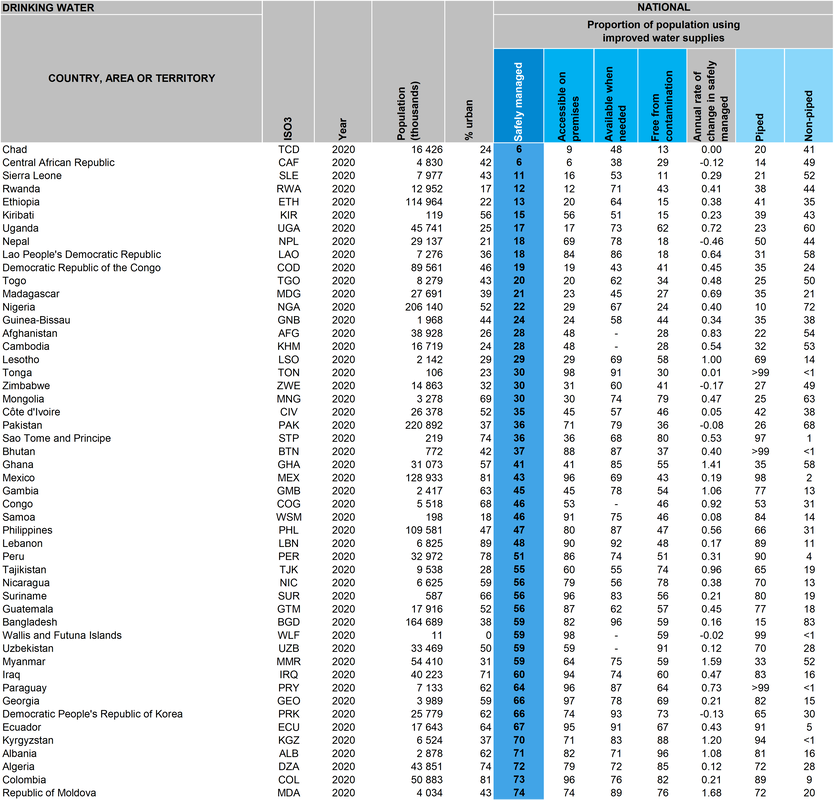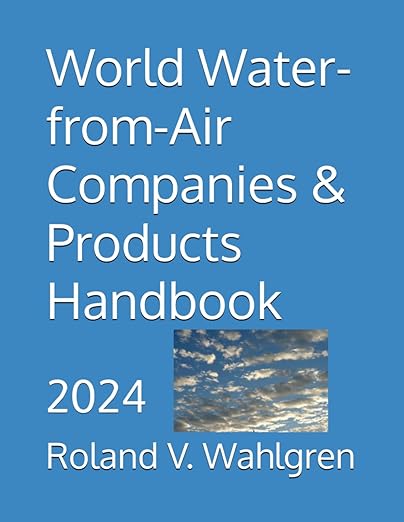 Go to article by clicking on image.
Go to article by clicking on image.
|
If you sell AWGs, I think the interactive map accompanying this Water Online article could serve as a useful guide for where to focus AWG marketing efforts in the USA.  Go to article by clicking on image. Go to article by clicking on image.
0 Comments
Some people prefer eBooks, others prefer printed books. Your choice!
Water-from-air technologies are attracting serious attention as shown by a recent editorial in the journal Nature Water. Highlights from the editorial include:
Here I refer again to statistics from UNICEF’s Water, Sanitation and Hygiene in Healthcare Facilities: Global Baseline Report 2019 which is found at: https://data.unicef.org/resources/wash-in-health-care-facilities/?mc_cid=f5b26e1fed&mc_eid=1956e675a7) The UNICEF report stated, “In 8 out of 55 countries with data available, more than half of health care facilities lacked handwashing facilities at points of care in 2016”. This is an urgent need that could be filled by appropriately designed AWGs. Today's post presents data about healthcare facilities with no handwashing facilities (Table 7, below).  Table 7: Twelve countries, areas, or territories where more than half of healthcare facilities lacked handwashing facilities at points of care. This 2019 data is for 72 of 165 countries in the database. For 93 countries there is no data for hand hygiene materials at points of care. This table was condensed by the writer from a larger table. Data source: Progress on household drinking water, sanitation and hygiene 2000-2020: five years into the SDGs. Geneva: World Health Organization (WHO) and the United Nations Children’s Fund (UNICEF), 2021. Licence: CC BY-NC-SA 3.0 IGO. Data gaps are indicated by a dash (-). The detailed statistical table from which the tables are derived is too large to reproduce in this blog series. The detailed table is available at https://washdata.org/data/downloads (select “World File” under “Health Care Facilities”). Water service data is given for the following regional groupings of healthcare facilities:
This is the final post in this 7-part series about water-from-air market analyses based on the UN's Sustainable Development Goal 6 (Clean Water and Sanitation). Perhaps this series will inspire readers to initiate projects aligned with SDG 6. This alignment will create a demand for AWGs designed to address needs beyond household drinking water. AWGs are needed for household sanitation, basic water services in schools, handwashing in schools, basic water services in healthcare facilities, and healthcare handwashing facilities. Innovative business models are needed to allow water-from-air system suppliers to participate in achieving SDG 6 targets. Statistics from UNICEF’s Water, Sanitation and Hygiene in Healthcare Facilities: Global baseline report 2019 https://data.unicef.org/resources/wash-in-health-care-facilities/?mc_cid=f5b26e1fed&mc_eid=1956e675a7) show the commercial potential for AWGs in the healthcare facility market in two market segments:
An estimated 896 million people use health care facilities with no water service and 1.5 billion use facilities with no sanitation service. It is likely that many more people are served by health care facilities lacking hand hygiene facilities and safe waste management. Today's post presents data about healthcare facilities with no water service (Table 6, below).  Table 6: Eighteen countries, areas, or territories have no water service in at least 20% of their healthcare facilities. This 2019 data is for 79 of 165 countries in the database. For 86 countries there is no data for no water service in healthcare facilities. This table was condensed by the writer from a larger table. Data source: Progress on household drinking water, sanitation and hygiene 2000-2020: five years into the SDGs. Geneva: World Health Organization (WHO) and the United Nations Children’s Fund (UNICEF), 2021. Licence: CC BY-NC-SA 3.0 IGO. Data gaps are indicated by a dash (-). It is often said that children are our future. This truism may explain the special interest shown by WHO and UNICEF in compiling statistics about school drinking water services (Table 4, below) and school basic hygiene (Table 5, to be posted later in Part 5 of 7). There is commercial potential for AWGs designed for use in schools in drinking water and handwashing applications. Drinking water AWGs for schools and AWGs for handwashing by students are market segments rarely mentioned by academic researchers developing AWGs and by businesses offering AWG products. Welcome exceptions are the atmospheric drinking water fountain products by Hydrosphair and Skywell. The tables show the enormous potential for appropriately designed AWGs. These tables show the national statistics. The world file tables available at https://washdata.org/data/downloads also show urban and rural statistics so quite detailed market analyses can be done. Countries, areas, or territories with school drinking water services less than 75% of school age population are listed here in Table 4.  Table 4: Forty-four countries, areas, or territories have school basic water services less than 75% of the school age population. This data is for 133 out of 180 countries in the database. For 47 countries there is no data for school basic water services. The blog author condensed and sorted the data according to lowest to highest national proportion of basic water services. Data source: Progress on household drinking water, sanitation and hygiene 2000-2020: five years into the SDGs. Geneva: World Health Organization (WHO) and the United Nations Children’s Fund (UNICEF), 2021. Licence: CC BY-NC-SA 3.0 IGO. Data gaps are indicated by a dash (-). Households, schools, and healthcare facilities are essential markets to focus on according to the WHO/UNICEF Joint Monitoring Program for Water Supply, Sanitation and Hygiene (JMP). JMP is the data-holding entity monitoring progress towards the SDG 6 targets. Other markets exist but those mentioned are global priorities for which improving water supplies will improve the lives of millions of people by 2030. To position an AWG technology to help solve global water scarcity problems quickly and efficiently it is wise to adopt the priority markets outlined in the data tables by the experts involved with JMP ( Table downloads at: https://washdata.org/data/downloads#). There are fifty countries, areas, or territories with data showing less than 75% of their population lives in households having safely managed drinking water (see Table 2 below). A safely managed water supply has all three of these properties: located on premises, available when needed and free from fecal and priority chemical contamination (WHO and UNICEF, 2017, p. 24). Households whose water supply lacks one or more of these properties are a commercial opportunity for AWGs. Examining the table at the national level reveals details about target markets. For example, in Uganda (seventh on the list, sorted by proportion of population using safely managed water supplies) only 17% of the population has water accessible on their premises. Despite this fact, water is available when needed for 73% of Ugandans. But, unfortunately, only 62% of people have access to water free from contamination. The statistics also show that only 23% of the improved water supply is piped—so decentralized water distribution solutions like AWGs are a good fit to the situation. The original full data tables, available from the WHO and UNICEF Joint Monitoring Program further organize the national data into its rural and urban components (https://washdata.org/data/downloads#). This allows AWG marketing strategy development to be quite efficient.  Table 2: Fifty countries, areas, or territories with household drinking water supply safely managed less than 75%. This data is for 138 out of 234 countries in the database. For 96 countries there is no data for safely managed water supplies. The image is an excerpt from a larger table. The blog author condensed and sorted the data according to lowest to highest national proportion of safely managed. Data source: Progress on household drinking water, sanitation and hygiene 2000-2020: five years into the SDGs. Geneva: World Health Organization (WHO) and the United Nations Children’s Fund (UNICEF), 2021. Licence: CC BY-NC-SA 3.0 IGO. Data table downloads (Microsoft Excel® format) are available at https://washdata.org/data/downloads#. Data gaps are indicated by a dash (-). The commercial potential of atmospheric water generators (AWGs) can be evaluated in the framework of the United Nations Sustainable Development Goals (SDGs). These global goals were set in 2015 by a unanimous vote in the UN General Assembly. The goals are to be met by 2030. The SDGs relevant to water resources make plain the urgent demand for specific products and services. They also state market segments and geographical regions that must be addressed to improve the quality of life for millions of people. In short, the SDG documents contain global market survey results, outlining concisely the big-picture problems that innovative products and services must help solve. As a reminder, and to put the water-related SDG in context, here is list of the seventeen SDGs (https://www.un.org/sustainabledevelopment/sustainable-development-goals/): 1. No Poverty 2. Zero Hunger 3. Good Health and Well-being 4. Quality Education 5. Gender Equality 6. Clean Water and Sanitation 7. Affordable and Clean Energy 8. Decent Work and Economic Growth 9. Industry, Innovation, and Infrastructure 10. Reduced Inequalities 11. Sustainable Cities and Communities 12. Responsible Consumption and Production 13. Climate Action 14. Life Below Water 15. Life on Land 16. Peace, Justice, and Strong Institutions 17. Partnerships for the Goals Each goal has a list of targets. Indicators measure progress towards achieving targets. The SDG relevant to AWG design is Goal 6, Clean Water and Sanitation. The following Table 1 is my interpretation of how SDG 6 targets translate into insights about commercial potential for AWGs and the market segments to be addressed. These insights may influence design paths taken towards the final commercial versions of AWGs. There is a lot to say about this topic, so I've prepared seven blog posts to be published as a series.
My goal is to remind readers of the scope of the water crisis. No single technology can hope to end the crisis. Solving water scarcity requires a variety of solutions applied thoughtfully region by region. Some powerful solutions are behavioral (and therefore essentially free of any cost in the long term). One example is reduction or elimination of mismanagement of surface water and groundwater. Another example is increased water conservation by individuals, businesses, and institutions. Some solutions are related to maintenance of water distribution infrastructure that should really be done anyway but require leadership and political willpower to include sufficient maintenance funds in budgets. A variety of technological solutions are also likely to be needed. Water-from-air can be a valuable gap-filler in situations where conventional water supply or conventional sanitation solutions are difficult to apply or have failed. The SDG 6-related data tables in the following posts reflect these difficulties and failures. Clearly, proponents of water-from-air technologies have an enormous range of water scarcity problems to help solve. The second blog post will look at national data for safely managed household drinking water. |
Roland Wahlgren
I have been researching and developing drinking-water-from-air technologies since 1984. As a physical geographer, I strive to contribute an accurate, scientific point-of-view to the field. Archives
May 2024
Categories
All
|






